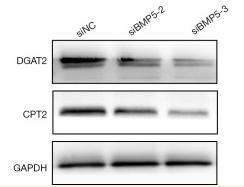DGAT2 Antibody - #DF9442
| Product: | DGAT2 Antibody |
| Catalog: | DF9442 |
| Description: | Rabbit polyclonal antibody to DGAT2 |
| Application: | WB IF/ICC |
| Cited expt.: | WB |
| Reactivity: | Human, Mouse, Rat |
| Prediction: | Pig, Bovine, Horse, Sheep, Rabbit, Dog, Chicken, Xenopus |
| Mol.Wt.: | 44 kDa, 55 kDa; 44kD(Calculated). |
| Uniprot: | Q96PD7 |
| RRID: | AB_2842638 |
Related Downloads
Protocols
Product Info
*The optimal dilutions should be determined by the end user. For optimal experimental results, antibody reuse is not recommended.
*Tips:
WB: For western blot detection of denatured protein samples. IHC: For immunohistochemical detection of paraffin sections (IHC-p) or frozen sections (IHC-f) of tissue samples. IF/ICC: For immunofluorescence detection of cell samples. ELISA(peptide): For ELISA detection of antigenic peptide.
Cite Format: Affinity Biosciences Cat# DF9442, RRID:AB_2842638.
Fold/Unfold
DGAT2; DGAT2_HUMAN; Diacylglycerol O acyltransferase like protein 2; Diacylglycerol O-acyltransferase 2; Diacylglycerol O-acyltransferase homolog 2 (mouse); Diacylglycerol O-acyltransferase homolog 2; Diacylglycerol O-acyltransferase-like protein 2 isoform 1; Diglyceride acyltransferase 2; DKFZp686A15125; GS1999full; HMFN1045;
Immunogens
A synthesized peptide derived from human DGAT2, corresponding to a region within the internal amino acids.
Predominantly expressed in liver and white adipose tissue. Expressed at lower level in mammary gland, testis and peripheral blood leukocytes. Expressed in sebaceous glands of normal skin but decreased psoriatic skin.
- Q96PD7 DGAT2_HUMAN:
- Protein BLAST With
- NCBI/
- ExPASy/
- Uniprot
MKTLIAAYSGVLRGERQAEADRSQRSHGGPALSREGSGRWGTGSSILSALQDLFSVTWLNRSKVEKQLQVISVLQWVLSFLVLGVACSAILMYIFCTDCWLIAVLYFTWLVFDWNTPKKGGRRSQWVRNWAVWRYFRDYFPIQLVKTHNLLTTRNYIFGYHPHGIMGLGAFCNFSTEATEVSKKFPGIRPYLATLAGNFRMPVLREYLMSGGICPVSRDTIDYLLSKNGSGNAIIIVVGGAAESLSSMPGKNAVTLRNRKGFVKLALRHGADLVPIYSFGENEVYKQVIFEEGSWGRWVQKKFQKYIGFAPCIFHGRGLFSSDTWGLVPYSKPITTVVGEPITIPKLEHPTQQDIDLYHTMYMEALVKLFDKHKTKFGLPETEVLEVN
Predictions
Score>80(red) has high confidence and is suggested to be used for WB detection. *The prediction model is mainly based on the alignment of immunogen sequences, the results are for reference only, not as the basis of quality assurance.
High(score>80) Medium(80>score>50) Low(score<50) No confidence
Research Backgrounds
Essential acyltransferase that catalyzes the terminal and only committed step in triacylglycerol synthesis by using diacylglycerol and fatty acyl CoA as substrates. Required for synthesis and storage of intracellular triglycerides. Probably plays a central role in cytosolic lipid accumulation. In liver, is primarily responsible for incorporating endogenously synthesized fatty acids into triglycerides (By similarity). Functions also as an acyl-CoA retinol acyltransferase (ARAT).
Endoplasmic reticulum membrane>Multi-pass membrane protein. Lipid droplet. Cytoplasm>Perinuclear region.
Predominantly expressed in liver and white adipose tissue. Expressed at lower level in mammary gland, testis and peripheral blood leukocytes. Expressed in sebaceous glands of normal skin but decreased psoriatic skin.
Belongs to the diacylglycerol acyltransferase family.
Research Fields
· Metabolism > Lipid metabolism > Glycerolipid metabolism.
· Metabolism > Global and overview maps > Metabolic pathways.
· Organismal Systems > Digestive system > Fat digestion and absorption.
References
Application: WB Species: Human Sample: 293T cells
Restrictive clause
Affinity Biosciences tests all products strictly. Citations are provided as a resource for additional applications that have not been validated by Affinity Biosciences. Please choose the appropriate format for each application and consult Materials and Methods sections for additional details about the use of any product in these publications.
For Research Use Only.
Not for use in diagnostic or therapeutic procedures. Not for resale. Not for distribution without written consent. Affinity Biosciences will not be held responsible for patent infringement or other violations that may occur with the use of our products. Affinity Biosciences, Affinity Biosciences Logo and all other trademarks are the property of Affinity Biosciences LTD.


